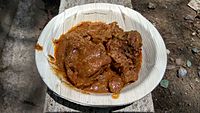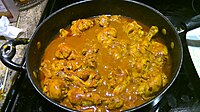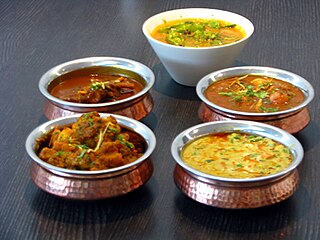
Curry is a dish with a sauce seasoned with spices, mainly associated with South Asian cuisine. It is not to be confused with leaves from the curry tree, though some curries do include curry leaves. Curry is also found in the native cuisines of many South East Asian and East Asian countries due to ancient contact with South Asia.

A chutney is a spread typically associated with cuisines of the Indian subcontinent. Chutneys are made in a wide variety of forms, such as a tomato relish, a ground peanut garnish, yogurt, or curd, cucumber, spicy coconut, spicy onion, or mint dipping sauce.

Momordica charantia is a tropical and subtropical vine of the family Cucurbitaceae, widely grown in Asia, Africa, and the Caribbean for its edible fruit. Its many varieties differ substantially in the shape and bitterness of the fruit.

Malay cuisine is the traditional food of the ethnic Malays of Southeast Asia, residing in modern-day Malaysia, Indonesia, Singapore, Brunei, Southern Thailand and the Philippines as well as Cocos Islands, Christmas Island, Sri Lanka and South Africa.

Fried rice is a dish of cooked rice that has been stir-fried in a wok or a frying pan and is usually mixed with other ingredients such as eggs, vegetables, seafood, or meat. It is often eaten by itself or as an accompaniment to another dish. Fried rice is a popular component of East Asian, Southeast Asian and certain South Asian cuisines, as well as a staple national dish of Indonesia. As a homemade dish, fried rice is typically made with ingredients left over from other dishes, leading to countless variations. Fried rice first developed during the Sui Dynasty in China.

Trinidad and Tobago has a unique history and its food is influenced by Indian-South Asian, West African, Creole, European, American, Chinese, Amerindian, and Latin American culinary styles. Trinidadian and Tobagonian food is dominated by a wide selection of dishes, most notably, doubles, roti, pelau, callaloo and curried crab and dumplings. Trinidad and Tobago is also known for its prepared provisions, such as dasheen, sweet potato, eddoes, cassava, yam, soups and stews, also known as blue food across the country. Corresponding to the Blue Food Day event held annually in Trinidad and Tobago.

Biryani is a mixed rice dish, mainly popular in South Asia. It is made with rice, some type of meat and spices. To cater to vegetarians, in some cases, it is prepared by substituting vegetables or paneer for the meat. Sometimes eggs and/or potatoes are also added.

Tamil cuisine is a culinary style of Tamil people originating in the southern Indian state of Tamil Nadu and neighboring Sri Lanka. Meats, along with rice, legumes, and lentils, are popular. Dairy products and tamarind are used to provide sour flavors. On special occasions, traditional Tamil dishes are served in a traditional manner, using banana leaves in place of utensils. After eating, the banana leaves are then used as a secondary food for cattle. A typical breakfast meal consists of idli or dosa with chutney. Lunch includes rice, sambar, curd, kuzhambu, and rasam.

Callaloo is a plant used in popular dishes in many Caribbean countries, while for other Caribbean countries, a stew made with the plant is called callaloo. Cuisines including the plant Callaloo or dishes called callaloo varies throughout the Caribbean. In countries such as Trinidad and Tobago or Grenada, the dish itself is called callaloo, and uses taro leaves or Xanthosoma leaves.
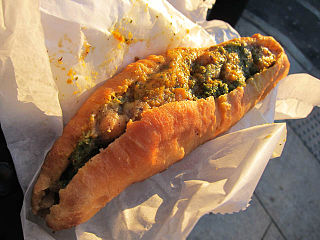
An aloo pie is a Caribbean fast food dish originating from and common in Trinidad and Tobago.

Noodle soup refers to a variety of soups with noodles and other ingredients served in a light broth. Noodle soup is a common dish across East Asia, Southeast Asia and the Himalayan states of South Asia. Various types of noodles are used, such as rice noodles, wheat noodles and egg noodles.

Rice vermicelli is a thin form of noodle. It is sometimes referred to as "rice noodles" or "rice sticks", but should not be confused with cellophane noodles, a different Asian type of vermicelli made from mung bean starch or rice starch rather than rice grains themselves.

Thai curry is a dish in Thai cuisine made from curry paste, coconut milk or water, meat, seafood, vegetables or fruit, and herbs. Curries in Thailand mainly differ from the curries in India in their use of ingredients such as fresh rhizomes, herbs, and aromatic leaves over a mix of dried spices.

Baigan bharta, also spelled bainganbharta or baigan chokha is an Indian dish prepared by mashing or mincing grilled eggplant (baigan) with tomato, onion, herbs and spices, with variations being common from chef to chef. Traditionally, cooking the eggplants over charcoals, inside of a tandoor, barbecue grill or oven, or even directly applying flame to the outside of the fruit infuses the dish with a smoky flavour; the blackened skin is then easily peeled and the eggplant may be further prepared.
Ohn no khao swè is a Burmese dish consisting of wheat noodles in a curried chicken and coconut milk broth thickened with gram flour. It features wheat noodles in a rich broth made with curried chicken and coconut milk, thickened with gram flour. Crispy fried bean fritters, hard-boiled eggs, sliced raw onions, chili peppers, and crispy noodles are added to the dish. Fish sauce and lime or lemon juice are then drizzled over everything.

Malaysian Indian cuisine, or the cooking of the ethnic Indian communities in Malaysia, consists of adaptations of authentic dishes from India, as well as original creations inspired by the diverse food culture of Malaysia. Because the vast majority of Malaysia's Indian community are of South Indian descent, and are mostly ethnic Tamils who are descendants of immigrants from a historical region which consists of the modern Indian state of Tamil Nadu and Sri Lanka's Northern Province, much of Malaysian Indian cuisine is predominantly South Indian inspired in character and taste. A typical Malaysian Indian dish is likely to be redolent with curry leaves, whole and powdered spice, and contains fresh coconut in various forms. Ghee is still widely used for cooking, although vegetable oils and refined palm oils are now commonplace in home kitchens. Before a meal it is customary to wash hands as cutlery is often not used while eating, with the exception of a serving spoon for each respective dish.

A stew is a combination of solid food ingredients that have been cooked in liquid and served in the resultant gravy. Ingredients can include any combination of vegetables and may include meat, especially tougher meats suitable for slow-cooking, such as beef, pork, venison, rabbit, lamb, poultry, sausages, and seafood. While water can be used as the stew-cooking liquid, stock is also common. A small amount of red wine or other alcohol is sometimes added for flavour. Seasonings and flavourings may also be added. Stews are typically cooked at a relatively low temperature, allowing flavours to mingle.
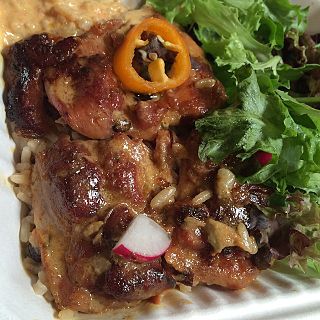
Pelau is a traditional rice dish from the West Indies. Its main ingredients typically include meat, rice, pigeon peas or cowpeas, coconut milk and sugar. Various vegetables and optional spices can be added. Common spices used in the dish are cardamom, cloves, cumin, and coriander. The meat is caramelised in brown sugar along with onion and garlic and the other ingredients are then added one by one, resulting in a dark brown stew.

Ginataang manok is a Filipino chicken stew made from chicken in coconut milk with green papaya and other vegetables, garlic, ginger, onion, patis or bagoong alamang, and salt and pepper. It is a type of ginataan. A common variant of the dish adds curry powder or non-native Indian spices and is known as Filipino chicken curry.

Burmese curry refers to a diverse array of dishes in Burmese cuisine that consist of protein or vegetables simmered or stewed in an aromatic curry base. Burmese curries generally differ from other Southeast Asian curries in that Burmese curries make use of dried spices in addition to fresh herbs and aromatics, and are often milder. Burmese curries are readily available in curry houses throughout the country. They are traditionally accompanied with rice and a variety of side dishes, soups, and Burmese salads called athoke. Burmese curries may also be paired with Indian breads like nanbya, palata, aloo puri, and toshay.

